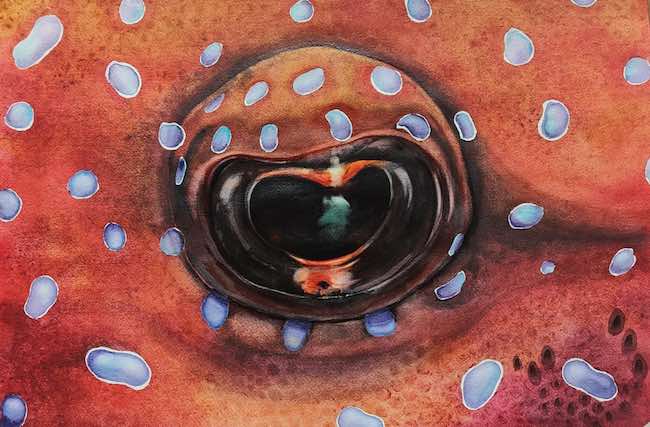L’artista spesso ha una sensibilità che gli consente di andare oltre il visibile e interpretare l’osservato attraverso il filtro della sua fantasia, del suo sguardo sul mondo, mostrando in questi casi un approccio visionario verso tutto ciò che circonda e appartiene all’ordinarietà del quotidiano. Alcuni creativi scelgono di rimanere all’interno di quel mondo immaginario attraverso il quale riescono a dare un’inedita interpretazione a tutto ciò che vedono, decontestualizzando il senso comune della realtà per renderla affine a quel loro punto di vista che a volte svela e a volte nasconde. La protagonista di oggi appartiene a questa categoria di artisti in grado di stravolgere il conosciuto per renderlo altro, e lo fa attraverso una tecnica pittorica da lei completamente personalizzata e modificata rispetto all’approccio più tradizionale.
Intorno alla prima decade del Novecento il modo di intendere la pittura e la scultura figurative subì un radicale cambiamento perché l’esigenza di rompere con un passato troppo tradizionale e poco affine alla direzione verso cui si muoveva la nuova società dell’epoca, e il bisogno di porre l’uomo con la sua interiorità e fragilità al centro della ricerca artistica, generarono correnti che, ciascuna a proprio modo, si ponevano come obiettivo di far emergere tutto ciò che a una prima frettolosa occhiata non appariva. Al di là del contesto della pura emozione dell’Espressionismo, dove sia l’immagine riprodotta sia la gamma cromatica dovevano necessariamente assecondarsi al sentire e alle tempeste interiori dei protagonisti come dell’esecutore dell’opera, e del Cubismo che svelava la necessità di scomposizione non solo del visibile ma anche una sorta di razionalizzazione del sentito che attraverso le forme geometriche doveva dare il senso della simultaneità dei vari livelli di osservazione, i movimenti che più di tutti riuscirono a scuotere le menti e le emozioni in virtù di quell’andare a indagare le energie sottili, il mistero e l’enigma nascosto all’interno di ogni oggetto e di ogni frangente dell’esistenza, furono la Metafisica e il Surrealismo. Nonostante la traccia di alcuni anticipatori come Hieronymus Bosch nel Cinquecento e di Arnold Böcklin a fine Ottocento, che furono veri e propri pionieri delle tematiche dei surrealisti con le loro intuizioni e la predisposizione nei confronti dell’inquietante, del misterioso e delle perversioni dell’essere umano, fu solo con il Ventesimo secolo e gli studi approfonditi sulla psiche condotti dal grande psicanalista Sigmund Freud, di fatto ispiratore delle ricerche sulle inquietudini, sulle ansia, sull’inconscio e sulla sessualità di cui sono piene le opere di Salvador Dalì, Francis Picabia, Man Ray. In questi artisti ciò che emergeva in maniera chiara era la loro visionarietà, quella particolare capacità di andare oltre l’osservato e di immaginare mondi paralleli dove anche ciò che appariva familiare era in realtà manifestazione di un universo onirico dove la mente non aveva alcun controllo, alcuna possibilità di dare una spiegazione logica. Il medesimo approccio visionario e immaginario appartiene all’artista di origini torinesi, ma ormai da tempo stabilitasi a Trieste, Carla Faggioni, la quale adatta uno stile abitualmente più legato a un diverso tipo di soggetti e di utilizzo cromatico come l’acquarello, alla capacità di andare oltre, di percepire qualcosa di differente rispetto allo sguardo realista che può essere dato al mondo che circonda l’individuo, dando così vita a serie pittoriche sorprendenti proprio in virtù della sua capacità di far emergere la fantasia, il sogno.
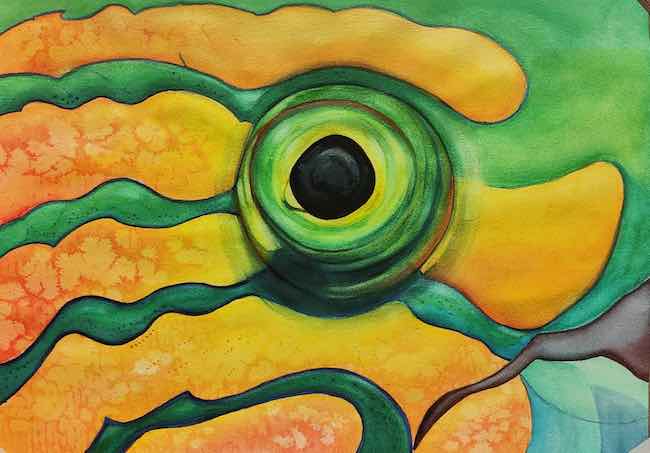
Il suo mondo artistico non tende verso le inquietudini e le angosce, come i dipinti di Dalì e di Picabia, piuttosto la trasposizione dell’osservato si avvicina di più alla tecnica di Man Ray di mettere in risalto gli sguardi in grado di assumere un’aura di mistero, inducendo il fruitore a domandarsi quale sia il messaggio nascosto oltre l’immediatezza delle immagini, nel caso del maestro del Novecento prevalentemente fotografiche. Nella serie più recente di Carla Faggioni l’inganno avviene attraverso il focus su occhi di pesci tropicali in versione macro che lei trasforma in veri e propri misteri provenienti da altri mondi, come se la gamma cromatica costituisse un elemento ipnotico, un terreno soprannaturale da cui gli sguardi emergono, come fossero simbolo di ribollimento di ciò che resta all’interno di un terreno, metafora della coscienza e della conoscenza, ma che poi si affaccia per uscire e trovare la luce.
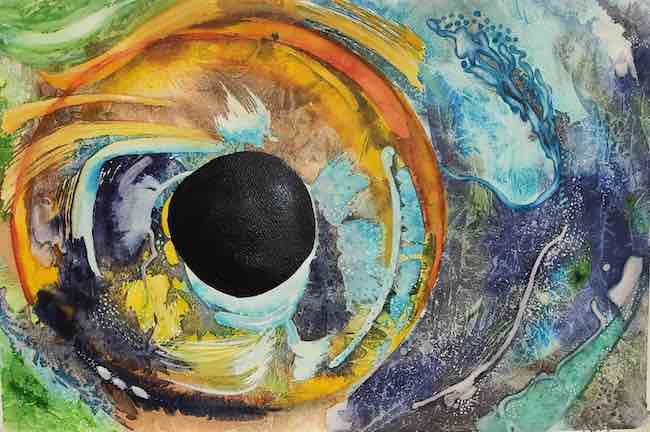
Carla Faggioni avverte e asseconda fin da giovane la sua inclinazione artistica, tanto quanto la sua attitudine a concentrarsi sul dettaglio, colpendo l’attenzione del suo primo maestro di disegno, Renato Nesi; nel corso degli anni successivi la frequentazione dell’ambiente artistico triestino le ha permesso di mettersi in discussione, misurarsi e scoprire, grazie alla scuola del maestro De Florio, a Treviso, la tecnica dell’acquarello che nel corso degli anni affina fino a giungere a una spiccata personalità espressiva attraverso la quale riesce a dare una sua impronta distintiva.
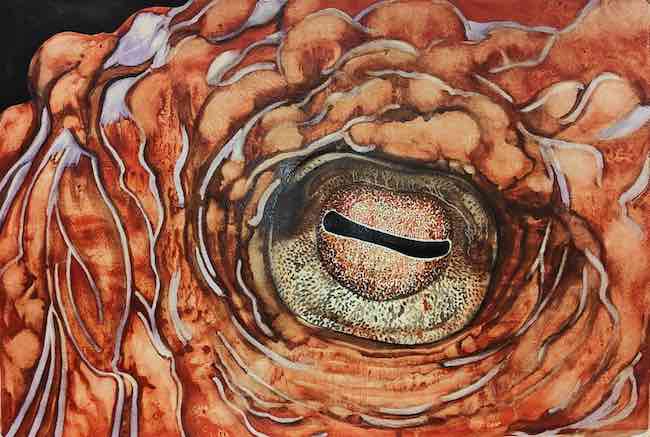
La diluizione del colore è quasi inesistente perché ciò che desidera far emergere è l’intensità di una tecnica spesso legata all’impalpabilità, più per tradizione e abitudine che non per reale esigenza esecutiva, mentre con la sua padronanza nell’utilizzo l’aspetto del colore cambia e assume una maggiore consistenza che si armonizza con la decisa impronta surreale della Faggioni.
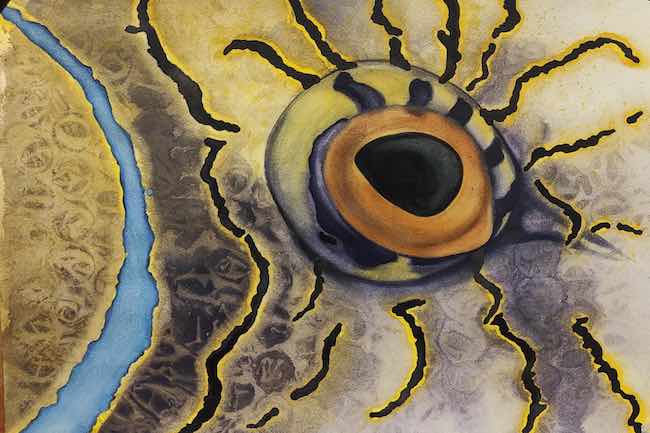
L’ispirazione per la serie di opere recenti si ispira a fotografie subacquee delle quali sceglie di prendere e riprodurre i dettagli degli occhi dei pesci, circondati dalle tinte forti e ipnotiche al punto di trasformare tutto ciò che circonda le pupille, e che sembrano scrutare l’osservatore chiedendo timidamente di essere notati andando al di là della prima apparenza, del primo impatto, e scendendo nelle profondità di un significato che si lega al senso del vivere contemporaneo, quello del mostrarsi attraendo l’attenzione in maniera palesemente estetica e poi, in chi sente la necessità di emergere dal silenzio della generalizzazione, di svelare lentamente la propria reale identità.
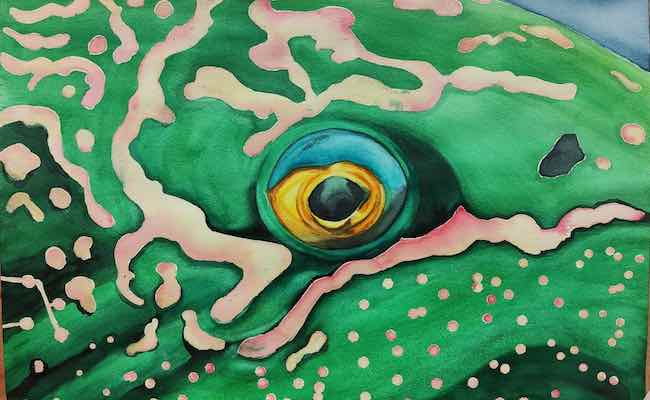
L’opera Ipnosis mostra una vera e propria mimetizzazione dello sguardo, allo stesso modo di come i pesci a volte cerchino di confondersi con il fondale marino o i coralli vicino a cui nuotano; tanto quanto modo l’uomo moderno che in modo camaleontico cerca di adeguarsi all’ambiente che lo circonda anche quando non è affine alla sua natura. Eppure emerge una profonda differenza tra lo sguardo narrato dalla Faggioni e l’individuo attuale poiché il primo sembra non dimenticare la sua identità, malgrado la consapevole esigenza di adeguare il suo aspetto all’habitat in cui si trova, mentre l’essere umano scorda e si perde a volte pur di nascondere ciò che teme potrebbe non piacere agli altri.
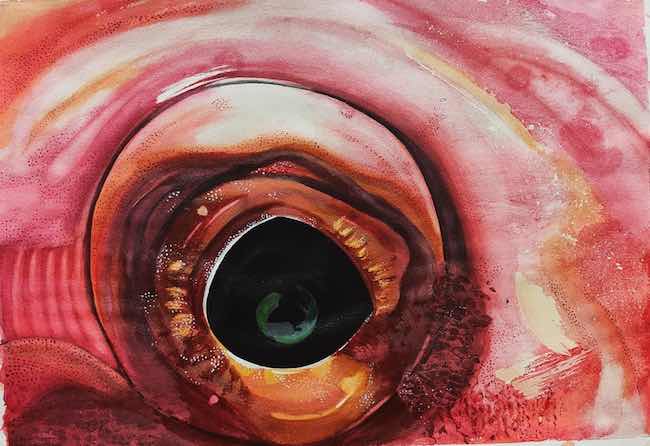
Dolore latente invece, malgrado l’apparenza quasi perplessa dello sguardo, o forse sarebbe meglio dire sonnolenta, calamita l’attenzione del fruitore verso la profondità dell’occhio, come un richiamo ad andare oltre ciò che sembra per scoprire ciò che è; ecco il motivo della parola latente nel titolo, perché troppo spesso nella società attuale si guarda solo distrattamente chi ci sta accanto, senza vedere davvero la sua sensibilità, i suoi drammi, i dolori che sta vivendo, dimenticandoci di essere umani. L’invito di Carla Faggioni è quello di avere un atteggiamento differente, più empatico, più di ascolto nei confronti di tutto ciò che ruota intorno perché è proprio nell’apertura che si nasconde la possibilità di interagire, comprendere ed evolvere.
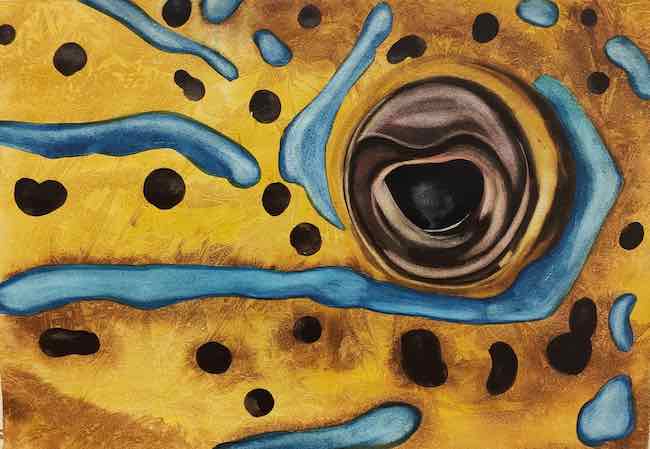
Il surreale diviene pertanto mezzo di conoscenza, di approfondimento, anche laddove l’irrealtà crea un distacco con il conosciuto, o forse proprio in virtù di quella distanza, come nell’opera Circondo il buio dove lo sfondo diviene protagonista dell’azione mentre il soggetto, l’occhio, diviene l’oggetto dell’atto delle tonalità circostanti che, come suggerito dal titolo, lo circondano per metterlo in evidenza, per porre l’attenzione proprio su quel buio, inteso come profondità del sentire che si svela grazie alle linee colorate che sembrano convogliare l’attenzione verso quel centro delle emozioni. In questo caso la sensazione è che l’occhio sia triste, avvolto da una malinconia malgrado la vivacità circostante, esattamente come accade nella vita in cui spesso l’individuo si trova a dover vivere le emozioni nel silenzio nascondendole all’esterno per un senso di pudore e di protezione della propria fragilità. Carla Faggioni ha frequentato per anni il salotto artistico del maestro Armando Pizzinato a Venezia; partecipa a mostre collettive e personali riscuotendo grande apprezzamento dal pubblico e dagli addetti ai lavori.
CARLA FAGGIONI-CONTATTI
Email: cfaggioni203@gmail.com
Facebook: https://www.facebook.com/carla.faggioni
Instagram: https://www.instagram.com/carlafaggioni3/
The surreal universe and imagined realities of Carla Faggioni’s watercolours
The artist often has a sensitivity that allows him to go beyond the visible and interpret the observed through the filter of his imagination, of his view of the world, showing in these cases a visionary approach to everything that surrounds and belongs to the ordinariness of everyday life. Some creatives choose to remain within that imaginary world through which they manage to give an unprecedented interpretation to everything they see, decontextualising the common sense of reality to make it akin to their point of view that sometimes reveals and sometimes conceals. Today’s protagonist belongs to this category of artists capable of distorting the known to make it something else, and she does so through a painting technique that she completely customises and modifies compared to the more traditional approach.
Around the first decade of the 20th century, the way of intending figurative painting and sculpture underwent a radical change because the need to break with a past that was too traditional and unsuited to the direction in which the new society of the time was moving, and the need to place man with his interiority and fragility at the centre of artistic research, generated currents that, each in their own way, set themselves the goal of bringing out everything that did not appear at first glance. Beyond the context of the pure emotion of Expressionism, where both the reproduced image and the chromatic range necessarily had to go along with the feeling and inner storms of the protagonists as well as the executor of the artwork, and Cubism, which revealed the need for decomposition not only of the visible but also a kind of rationalisation of the felt that through geometric forms had to give a sense of the simultaneity of the various levels of observation, the movements that most of all succeeded in shaking minds and emotions by virtue of that quest to investigate the subtle energies, the mystery and enigma hidden within every object and every juncture of existence, were Metaphysics and Surrealism.
Despite the trace of a few forerunners such as Hieronymus Bosch in the 16th century and Arnold Böcklin in the late 19th century, who pioneered the themes of the Surrealists with their insights and predisposition towards the uncanny, the mysterious and the perversions of human beings, it was only with the 20th century and the in-depth studies of the psyche conducted by the great psychoanalyst Sigmund Freud, who inspired the research into restlessness, anxiety, the unconscious and sexuality of which the works of Salvador Dali, Francis Picabia and Man Ray are full. In these artists, what emerged clearly was their visionary nature, that particular ability to go beyond the observed and imagine parallel worlds where even what appeared familiar was actually a manifestation of a dreamlike universe where the mind had no control, no possibility of giving a logical explanation. The same visionary and imaginary approach belongs to Carla Faggioni, an artist originally from Turin, but now long established in Trieste. She adapts a style that is usually more linked to a different type of subject and use of colour such as watercolour, to the ability to go beyond, to perceive something different from the realist gaze that can be given to the world that surrounds the individual, thus giving rise to surprising pictorial series precisely because of her ability to bring out the imagination, the dream. Her artistic world does not tend towards restlessness and anguish, like the paintings of Dali and Picabia, rather the transposition of the observed is closer to Man Ray’s technique of emphasising gazes capable of assuming an aura of mystery, inducing the viewer to wonder what is the hidden message beyond the immediacy of the images, in the case of the 20th century master predominantly photographic. In Carla Faggioni’s most recent series, the deception takes place through the focus on the eyes of tropical fish in macro version that she transforms into real mysteries from other worlds, as if the chromatic range constituted a hypnotic element, a supernatural terrain from which the gazes emerge, as if they were symbols of the simmering of what remains within a terrain, a metaphor for consciousness and knowledge, but which then emerges to find the light. From a young age, Carla Faggioni sensed and indulged her artistic inclination, as much as her aptitude for focusing on detail, which caught the attention of her first drawing master, Renato Nesi; in the years that followed, her frequentation of the artistic environment in Trieste allowed her to challenge herself, measure herself and discover, thanks to the school of master De Florio in Venice, the technique of watercolour painting, which she refined over the years until she achieved a marked expressive personality through which she was able to make her own distinctive mark. The dilution of the colour is almost non-existent because what she wishes to bring out is the intensity of a technique that is often linked to impalpability, more by tradition and habit than by any real need for execution.
With her mastery in its use, the appearance of the colour changes and takes on a greater consistency that harmonises with Faggioni’s decisive surreal imprint. The inspiration for her series of recent works is inspired by underwater photographs of which she chooses to take and reproduce the details of fish eyes, surrounded by strong, hypnotic colours to the point of transforming everything around the pupils, and which seem to be scrutinising the observer, shyly asking to be noticed, going beyond first appearances, of the first impact, and descending into the depths of a meaning that is linked to the sense of contemporary living, that of showing oneself by attracting attention in an overtly aesthetic manner and then, in those who feel the need to emerge from the silence of generalisation, slowly revealing their real identity. The artwork Ipnosis shows a true camouflage of the gaze, in the same way that fish sometimes try to blend in with the seabed or the corals near which they swim; just as much as modern man, who in a chameleon-like manner tries to adapt to his surroundings even when they are not akin to his nature. And yet a profound difference emerges between the gaze narrated by Faggioni and the present-day individual, since the former does not seem to forget his identity, despite the conscious need to adapt his appearance to the habitat in which he finds himself, while the human being forgets and sometimes loses himself in order to hide what he fears might not please others. Latent pain, on the other hand, despite the almost perplexed appearance of the gaze, or perhaps it would be better to say somnolent, attracts the viewer’s attention to the depths of the eye, like a call to go beyond what it seems to be to discover what it is; this is the reason for the word latent in the title, because too often in today’s society we only look distractedly at those around us, without really seeing their sensitivity, their dramas, the pain they are experiencing, forgetting that we are human.
Carla Faggioni’s invitation is to have a different attitude, more empathetic, more listening towards everything that revolves around because it is precisely in openness that the possibility of interacting, understanding and evolving is hidden. The surreal therefore becomes a means of knowledge, of deepening, even where unreality creates a detachment with the known, or perhaps precisely by virtue of that distance, as in the work I circle the darkness where the background becomes the protagonist of the action while the subject, the eye, becomes the object of the act of the surrounding tones that, as the title suggests, surround it to highlight it, to focus attention precisely on that darkness, intended as the depth of feeling that is revealed thanks to the coloured lines that seem to channel attention towards that centre of emotions. In this case, the sensation is that the eye is sad, enveloped in melancholy despite the surrounding liveliness, exactly as happens in life where the individual often has to experience emotions in silence, hiding them from the outside world out of a sense of modesty and protection of his own fragility. Carla Faggioni frequented for years the artistic salon of master Armando Pizzinato in Venice; she took part in group and solo exhibitions, gaining great appreciation from the public and professionals.


